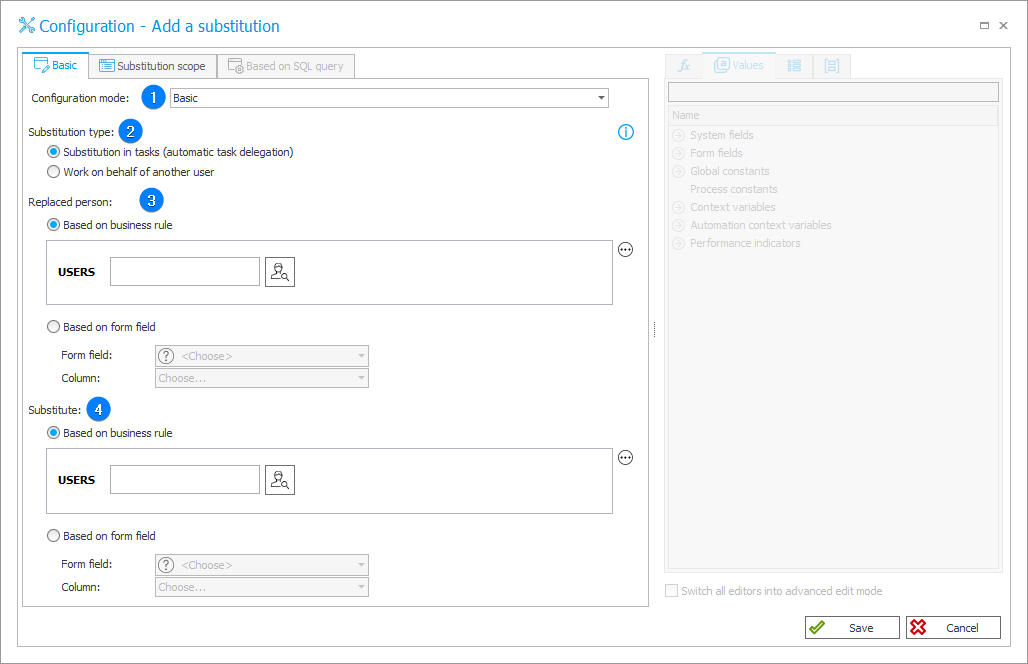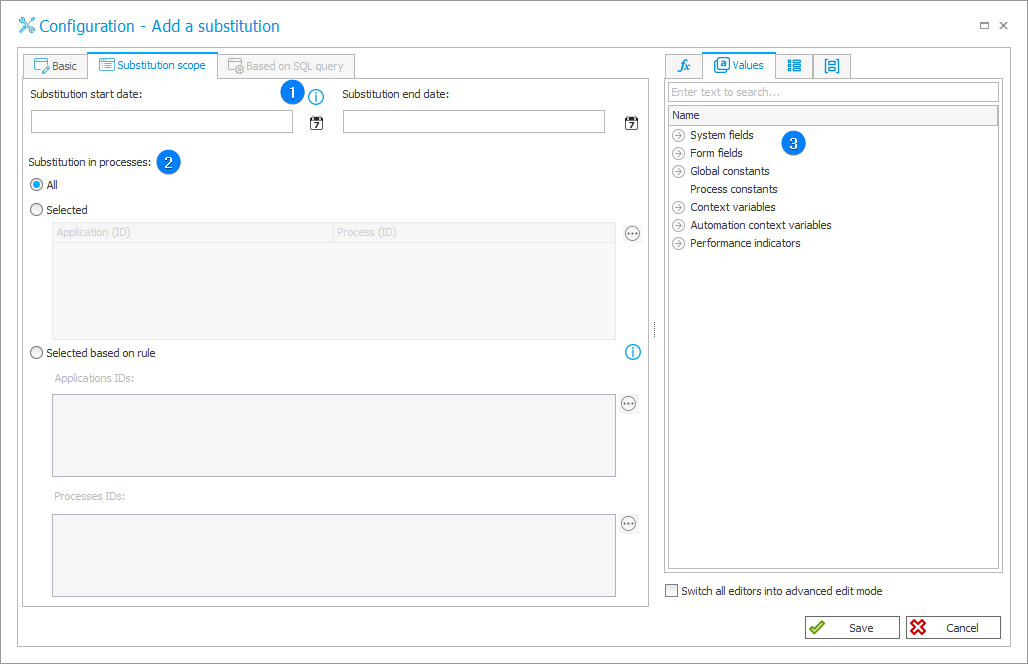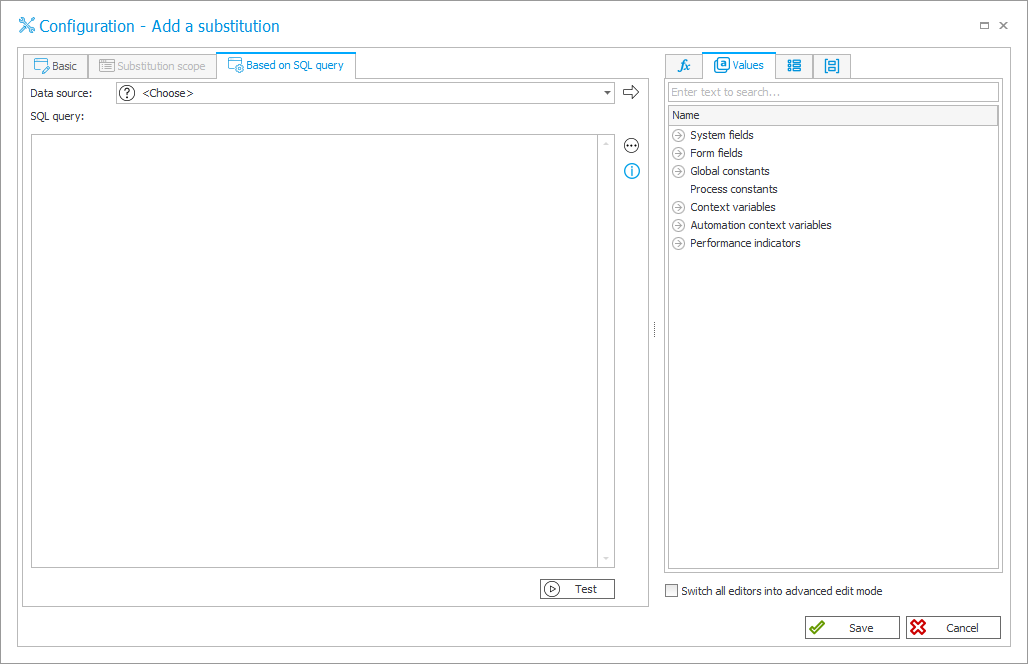Add a substitution
Substitutions in WEBCON BPS are one of the features for optimizing business processes. This action is used to handle substitutions for an absent employee (system user).
The action configuration window has three tabs: Basic, Substitution scope, Based on SQL query.
Basic
This tab that allows you to configure the basic parameters of the substitution.

1. Configuration mode
Select how the action will be configured:
- Basic – the action will be configured with the parameters available in the current tab. The Based on SQL tab will not be available.
- Based on SQL query – the action will be configured based on the SQL query. If you select this option, all parameters in the tab will no longer be available and you can edit the Based on SQL tab.
2. Substitution type
The following checkboxes are available in this section:
- Substitution in tasks (automatic task delegation) – when creating a task for the substituted person, an additional task will be created for the substitute. The substitute will be able to perform task in the place of the substituted person. Settings for substitutions of this type are also available from Task creation.
- Work on behalf of another user – this type of substitution allows the substitute to work in the process with the same privileges as the substituted person. Apart from performing tasks, the substitute will be able to, e.g. start or modify an instance, and will have access to reports and dashboards. All operations performed by the substitute will be signed as if the substituted person had performed those operations. Settings for substitutions of this type are also available from Settings of the process.
3. Replaced person
Define a replaced user. They can be defined Based on business rule or Based on form field.
4. Substitute
Define a substitute. They can be defined Based on business rule or Based on form field.
Substitution scope
The tab is used to configure the time and process parameters of the substitution.

1. Substitution time interval
Specify the substitution start and end dates.
Enter the date manually in YYYY-MM-DD format or select the date from the calendar by clicking on the icon next to the selected field. All data should be specified in the time zone of the database (UTC +01.00). If the start date has already occurred, the current date and time will be used instead.
2. Substitution in processes
Select applications and processes in which it will be possible to act on behalf of another user.
For processes Selected based on rule, the configuration allows you to indicate a list of applications and processes' IDs for which a substitution is to be created (a list in the form of IDs separated by a semicolon). Application IDs must coincide with process IDs. It means that when creating a substitution for a specific process, it is required to indicate an application in which the process is defined. Providing application IDs is optional. If the application ID will not be specified, the substitute will not have access to the application (reports, dashboards, starts); however, they will be able to work within the specified process.
If the process is related to several application, provide IDs of those applications in which the process is to be available.
3. Variables editor
Dynamically generated tree containing all variables that may be used in the current location of Designer Studio. Information on how to use variables in WEBCON BPS, as well as a list of variables can be found here.
Based on SQL query
Use this tab to configure the action based on an SQL query.

When using an SQL query, the returned data should be in the following format:
- Person* <string> – the person being substituted; domain and login or UPN:
webcon\f.lastorf.last@webcon.com, - Acting* <string> – the person who is the substitute; domain and login or UPN,
- DateFrom* <datetime> – substitution start date,
- DateTo* <datetime> – substitution end date,
- Type <int?> – substitution type: NULL or 0 – Task delegation, 1 – Working on behalf of the replaced person.
Optional column, if it is not defined in the source, then a substitution of the Task delegation type will be created. - ProcessID – ID of the processes (separated by a comma) to which the substitution applies. If the value NULL is returned, the substitution will apply to all processes with the option of handling substitutions enabled in the process configuration, such as Task delegation or On behalf. In the case of defining the substitution On behalf, the [ApplicatonID] column should be filled in with the application ID in the context of which the process is to be available.
This column is optional. - ApplicatonID – IDs of the applications to which the On behalf substitution type applies. For Task delegation substitution type, the values of this column are ignored. The column should return the application identifiers (separated by a comma) to which the substitute is to have access while working on behalf of the replaced person. The identifiers returned in this column are closely related to the process identifiers returned in the [ProcessID] column. It means that when creating a substitution for a specific process, you must also provide the ID of the application in which this process is located (related or parent). If the application ID is not provided, the substitute will have access to the process data (creating, editing, tasks) on behalf of the replaced person, but will not have access to the application (reports, dashboards).
If you want to define a substitution for all processes (where working on behalf of the replaced person is possible), return NULL in all applications containing these processes in the [ApplicatonID] and [ProcessID] columns. This column is optional. - CompanyID <int?> – ID of the company affected by the substitution (NULL for all companies). This column is optional.
For more information on substitutions, see the articles: